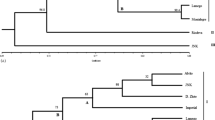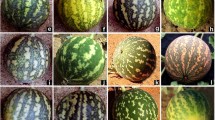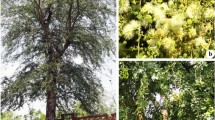Abstract
An investigation of randomly amplified polymorphic DNA (RAPD) and polymerase chain reaction-restriction fragment length polymorphism (PCR-RFLP) marker distribution was made for two well-characterised hybrids and their parents,Leucaena leucocephala andL. esculenta andParkinsonia aculeata andCercidium praecox. Three chloroplast DNA (cpDNA) markers identified the maternal parent of eachL. leucocephala ×L. esculenta hybrid. Fifteen species-diagnostic RAPD markers (invariant in one taxon and absent from the other) were always present in theLeucaena hybrid and assumed to be of nuclear origin, whilst three RAPD markers showed expression patterns identical to the cpDNA markers and were assumed to be of organellar origin. No RAPD or PCR-RFLP taxon-diagnostic markers were discovered for eitherP. aculeata orC. praecox. However, 21 RAPD markers were species-specific (polymorphic within one taxon but absent from the other) and Southern analysis indicated that none of the markers were of organellar origin. Only 67% additivity of markers specific toP. aculeata andC. praecox was demonstrated in the hybrids between these two species, whilst inLeucaena 97% additivity was demonstrated. Differences between the two hybridising situations were related to the behaviour of the molecular markers and the biology of the species.
Similar content being viewed by others
References
Adams, R. P., 1982: A comparison of multivariate methods for the detection of hybridisation. — Taxon31: 646–661.
Anderson, E., 1949: Introgressive hybridisation. — New York: Wiley.
Arnold, M. L., Buckner, C. M., Robinson, J. J., 1991: Pollen-mediated introgression and hybrid speciation in Louisiana irises. — Proc. Natl. Acad. Sci. USA88: 1398–1402.
Avise, J. C., 1994: Molecular markers, natural history and evolution. — New York: Chapman & Hall.
, 1984: Hybridisation and introgression among species of sunfish (Lepomis): Analysis by mitochondrial DNA and allozyme markers. — Genetics108: 237–255.
Backeljau, T., De Bruyn, L., De Wolf, H., Van Dongen, S., Verhagen, R., Winnepenninckx, B., 1995: Randomly amplified polymorphic DNA and parsimony methods. — Cladistics11: 119–130.
Black, W. C., 1993: PCR with arbitrary primers: approach with care. — Insect Molec. Biol.2: 1–6.
Carter, A. M., Rem, N. C., 1974: Pollen studies in relation to hybridisation inCercidium andParkinsonia (Leguminosae;Caesalpinioideae). — Madroño22: 301–311.
Chase, M. W., Hills, H. G., 1991: Silica gel: an ideal material for field preservation of leaf samples for DNA studies. — Taxon40: 215–220.
Clark, A. G., Lanigran, C. M. S., 1993: Prospects for estimating nucleotide divergence with RAPDs. — Molec. Biol. Evol.10: 1096–1111.
Crawford, D. J., Brauner, S., Cosner, M. B., Stuessy, T. F., 1993: Use of RAPD markers to document the origin of the intergeneric hybrid ×Margyracaena skottsbergii (Rosaceae) on the Juan Fernandez Islands. — Amer. J. Bot.80: 89–92.
Dawson, I. K., Simons, A. J., Waugh, R., Powell, W., 1996: Detection and pattern of interspecific hybridisation betweenGliricidia sepium andG. maculata in Meso-America revealed by PCR-based assays. — Molec. Ecol.5: 89–98.
Dewayne Shoemaker, D., Ross, K. G., Aronold, M. L., 1994: Development of RAPD markers in two introduced fire ants,Solenopsis invicta andS. richteri, and their application to the study of a hybrid zone. — Molec. Ecol.3: 531–539.
Doyle, J. J., Beachy, R. N., Lewis, W. H., 1984: Evolution of rDNAs inClaytonia polyploid complexes. — InGrant, W. F., (Ed.): Plant biosystematics, pp. 321–341. — London: Academic Press.
, 1989: 5s nuclear ribosomal gene variation in theGlycine tomentella polyploid complex. — Syst. Bot.14: 621–624.
Feinberg, A. P., Vogelstein, B., 1983: A technique for radiolabelling DNA restriction endonuclease fragments to high specific activity. — Ann. Biochem.132: 6–13.
Gottlieb, L. D., 1972: Levels of confidence in the analysis of hybridisation in plants. — Ann. Missouri Bot. Gard.59: 435–446.
Grant, W. F., (Ed.) 1984: Plant biosystematics. — Toronto, London: Academic Press.
Hadrys, H., Balick, M., Schierwater, B., 1992: Applications of random amplified polymorphic DNA (RAPD) in molecular ecology. — Molec. Ecol.1: 55–63.
Ham, R. C. H. J. Van, 't Hart, H., Mes, T. H. M., Sandbrink, J. M., 1994: Molecular evolution of non-coding regions of the chloroplast genome in theCrassulaceae and related species. — Curr. Genet.25: 558–566.
Harris, S. A., 1995: Systematics and randomly amplified polymorphic DNA in the genusLeucaena (Leguminosae, Mimosoideae). — Pl. Syst. Evol.197: 195–208.
, 1993: A molecular study of genetic resources in the genusLeucaena Benth. Final Report. — London: Forestry Research Programme, Overseas Development Administration.
, 1994: Genetic variation inLeucaena leucocephala (Lam.)de Wit. (Leguminosae: Mimosoideae). — Silvae Genet.43: 159–167.
Hawkins, J. A., 1996: Systematics ofParkinsonia L. andCercidium Tul. (Leguminosae: Caesalpinioideae). — Ph.D. Thesis, University of Oxford, UK.
-White Olascoaga, L., Hughes, C. E., Contreras Jiménez, J.-L. R., Mercado Rvaro, P., 1998: Investigation and documentation of hybridization betweenParkinsonia aculeata andCercidium praecox (Leguminosae: Caesalpinioideae). — Pl. Syst. Evol. (in press).
Heun, M., Helentjaris, T., 1993: Inheritance of RAPDs in F1 hybrids of corn. — Theor. Appl. Genet.85: 961–968.
Hillis, D. M., Moritz, C., Mable, B. K., 1996: Molecular systematics. — Sunderland, Massachusetts: Sinauer Associates.
Hughes, C. E., (1998): Monograph ofLeucaena Benth. — Syst. Bot. Monogr.55 (in press).
, 1994: The characterisation and identification of a naturally occurring hybrid in the genusLeucaena (Leguminosae: Mimosoideae). — Pl. Syst. Evol.192: 177–197.
Levin, D. A., Fransisco-Ortega, J., Jansen, R. K., 1996: Hybridisation and the extinction of rare plant species. — Conservation Biol.10: 10–16.
Lorenz, M., Weihe, A., Börner, T., 1994: DNA fragments of organellar origin in random amplified polymorphic DNA (RAPD) patterns of sugar beet (Beta vulgaris L.). — Theor. Appl. Genet.88: 775–779.
Mandany, M. H., 1991: Living fences: Somali farmers adopt an agroforetry technology. — Agroforestry Today3: 4–7.
Marsolais, J. V., Pringle, J. S., White, B. N., 1993: Assessment of random polymorphic DNA (RAPD) as genetic markers for determining the origin of interspecific lilac hybrids. — Taxon42: 531–537.
McDade, L. A., 1995: Hybridisation and phylogenetics. — InHoch, P. C., Stephenson, A. G., (Eds): Experimental and molecular approaches to plant biosystematics, pp. 305–331. — St. Louis: Missouri Botanical Garden.
N'Goran, J. A. K., Laurent, V., Rissterucci, A. M., Lanaud, C., 1994: Comparative genetic diversity studies ofTheobroma cacao L. using RFLP and RAPD markers. — Heredity73: 589–597.
Perez de la Rosa, J., Harris, S. A., Farjon, A., 1995: Noncoding chloroplast DNA variation in Mexican pines. — Theor. Appl. Genet.91: 1101–1106.
Pound, B., Martinez-Cairo, L., 1983:Leucaena: its cultivation and use. — London: Overseas Development Administration.
Rieseberg, L. H., 1995: The role of hybridisation in evolution: old wine in new skins. — Amer. J. Bot.82: 944–953.
, 1988: A molecular re-examination of introgression betweenHelianthus annuus andH. bolanderi (Compositae). — Evolution42: 227–238.
, 1989: Hybridisation in the island endemic,Catalina mahogany. — Conservation Biol.3: 52–58.
, 1992: Molecular evidence and plant introgression. — InSoltis, P. S., Soltis, D. E., Doyle, J. J., (Eds): Molecular systematics of plants, pp. 151–176. — London: Chapman & Hall.
, 1993: What can molecular and morphological markers tell us about plant hybridisation? — C. R. C. Crit. Rev. Pl. Sci.12: 213–241.
, 1995: Character expression, phylogenetic reconstruction and the detection of reticulate evolution. — InHoch, P. C., Stephenson, A. G., (Eds): Experimental and molecular approaches to plant biosystematics. — St. Louis: Missouri Botanical Garden.
Rosen, D. E., 1979: Fishes from the upland and intermontane basins of Guatemala: revisionary studies and comparative biogeography. — Bull. Amer. Mus. Nat. Hist.162: 267–376.
Smith, J. J., Scott-Craig, J. S., Leadbetter, J. R., Bush, G. L., Roberts, D. L., Fulbright, D. W., 1994: Characterization of random amplified polymorphic DNA (RAPD) products fromXanthomonas campestris and some comments on the use of RAPD products in phylogenetic analysis. — Molec. Phylogenet. Evol.3: 135–145.
Soltis, D. E., Soltis, P. S., 1991: Allopolyploid speciation inTragopogon: insights from chloroplast DNA. — Amer. J. Bot.76: 1119–1124.
Stace, C. A., 1975: Hybridisation and the flora of the British Isles. — London: Academic Press.
, 1989: Plant taxonomy and biosystematics. — London: Edward Arnold.
Stewart, J. L., Dunsdon, A. J., Hellin, J. J., Hughes, C. E., 1992: Wood biomass estimation of Central American dry zone trees. — Tropical Forestry Papers 26. — Oxford: Oxford Forestry Institute.
Taberlet, P., Gielly, L., Pautou, G., Bouvet, J., 1991: Universal primers for amplification of three non-coding regions of chloroplast DNA. — Pl. Molec. Biol.17: 1105–1109.
Thormann, C. E., Ferreira, M. E., Camargo, L. E. A., Tivang, J. G., Osborn, T. C., 1994: Comparison of RFLP and RAPD markers to estimating genetic relationships within and among cruciferous species. — Theor. Appl. Genet.88: 973–980.
Wachira, F. N., Waugh, R., Hackett, C. A., Powell, W., 1995: Detection of genetic diversity in tea (Camellia sinesis) using RAPD markers. — Genome38: 201–210.
Wagner, W. H., 1969: The role and taxonomic treatment of hybrids. — Bioscience19: 785–789.
Wang, W. Y., Pai, R. C., Lai, C. C., Lin, T. P., 1994: Molecular evidence for the hybrid origin ofPaulownia taiwaniana based on RAPD markes and RFLP of chloroplast DNA. — Theor. Appl. Genet.89: 271–275.
Wells, H., 1980: Adistance coefficient as a hybridisation index: an example usingMimulus longiflorus andM. flemingii (Scrophulariaceae) from Santa Cruz Island, California. — Taxon29: 52–65.
Weir, B. S., 1990: Genetic data analysis: methods for discrete population genetic data. — Sunderland, Massachusetts: Sinauer.
Williams, J. G. K., Hanafey, M. K., Rafalski, J. A., Tingey, S. V., 1993: Genetic analysis using random amplified polymorphic DNA markers. — Meth. Enzymol.218: 704–740.
Wilson, P., 1992: On inferring hybridity form morphological intermediacy. — Taxon41: 11–23.
Woods, W., 1992: Phytophagous insects collected fromParkinsonia aculeata (Leguminosae: Caesalpiniaceae) in the Sonoran Desert region of the southwestern United States and Mexico. — Entomophaga37: 465–474.
Zande, L. van de Bijlsma, R., 1995: Limitations of the RAPD technique in phylogeny reconstruction inDrosophila. — J. Evol. Biol.8: 645–656.
Author information
Authors and Affiliations
Rights and permissions
About this article
Cite this article
Hawkins, J.A., Harris, S.A. RAPD characterisation of two neotropical hybrid legumes. Pl Syst Evol 213, 43–55 (1998). https://doi.org/10.1007/BF00988907
Received:
Revised:
Accepted:
Issue Date:
DOI: https://doi.org/10.1007/BF00988907




